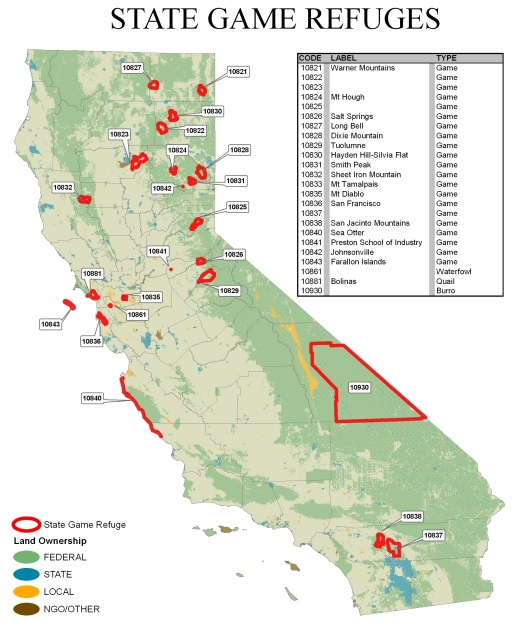The California Legislature has directed the California Department of Fish and Wildlife to review and evaluate the existing State Game Refuge system. A State Game Refuge is an area of land on which hunting is not permitted at any time unless specifically authorized by the Fish and Game Commission.
In 2008, CDFW proposed a legislative change to eliminate the State Game Refuge status of some areas. The proposed change in status would open these lands to public and private use, consistent with adjacent properties, and consistent with other refuges managed by the state and federal government. The Legislature directed the Department to seek public input on this topic.
The following information is provided in accordance with SB 1166 (2008) to inform and educate the public and solicit public comments regarding the State Game Refuges. CDFW must provide a summary of relevant comments and other information provided by the public to the Legislature by January 1, 2011.

Click on any section on the map above or the links below to view more detailed maps of the game refuges.
Bay | Coast | Inyo | Lake | Northeast | Southern | Tahoe
Background
State Game Refuges were established in the 1910's intending to enhance deer populations in certain parts of California, because of a lack of protections afforded deer from hunting. These small islands of property are "no hunting" areas, although other recreational and commercial land use activities are not restricted and the lands are not managed to benefit wildlife. They are not lands owned or administered by CDFW. CDFW biologists and other experts have acknowledged for the last several decades that the State Game Refuges have been an ineffective tool in achieving deer herd management goals and that modern regulatory mechanisms and protections are adequate.
Other States
In other states, State Game Refuges are typically sites owned and managed by the government of that state. Hunting activities are usually allowed within the refuge perimeter.
However, most State Game Refuges in California are located on privately owned land or on public lands managed by the U.S. Forest Service and are merely "no hunting" zones rather than refuges.
The exceptions are CDFW-owned wildlife areas (such as Gray Lodge and the Grizzly Island Wildlife Area) and Federal Refuges, which are managed by the U.S. Fish and Wildlife Service. Hunting activities are allowed in both types of areas.
Effects of Changing Refuge Status
Removing the legal designation of "State Game Refuge" from these areas will benefit CDFW law enforcement operations and constituents who participate in hunting. The scientific community's knowledge of wildlife ecology and behavior has increased since these refuges were created, and based on this information, CDFW has developed significant regulatory processes to protect and enhance wildlife populations. Elimination of the "State Game Refuge" designation will have no significant impact on the wildlife and ecosystems of these lands. Elimination of any refuges status would increase the amount of private and public land open to hunting in California.
The primary result of eliminating the designation is expected to be an influx of hunters having recreational opportunity in new areas and a change in the general purpose for which CDFW Wardens patrol the areas. A change in status is not expected to impact the necessary levels of law enforcement staffing, time or equipment required to continue enforcing the laws in these areas.
Economic Impact
CDFW does not anticipate any economic impact to the public or to the Department should any refuge(s) be eliminated.
Legal Impact
The elimination of the "State Game Refuge" designation may ultimately result in the issuance of fewer game law citations, as the current designation is known to cause confusion. Many of these areas currently lack sufficient signage, and are not known to hunters who are hunting in unfamiliar grounds.
California Game Refuges Under Review
The State Game Refuges under consideration for a change in status are described in the California Fish and Game Code, sections 10820 to 10842, excluding §10840 (Sea Otter Range). Note the refuges are called "districts" in the statute (e.g., "District 1C" in Modoc County).
Summary Report
CDFW's summary report to the Legislature on State Game Refuges: